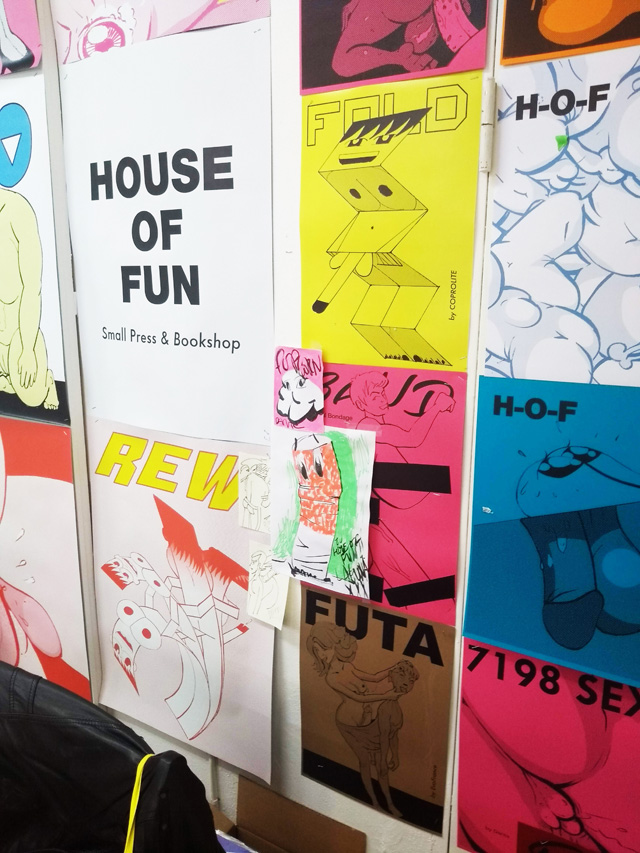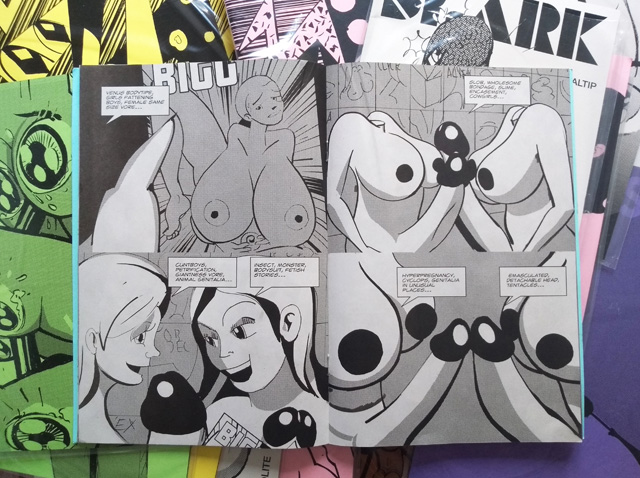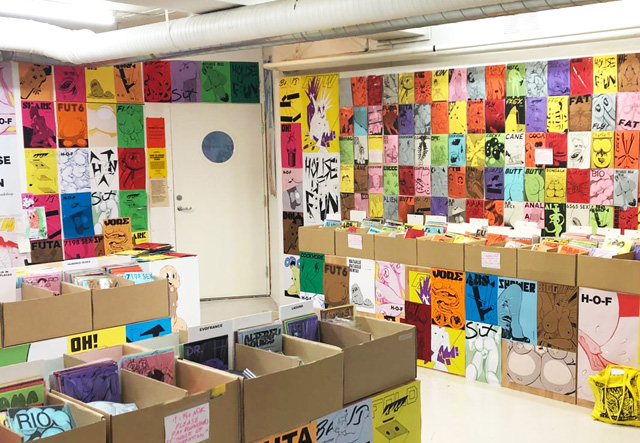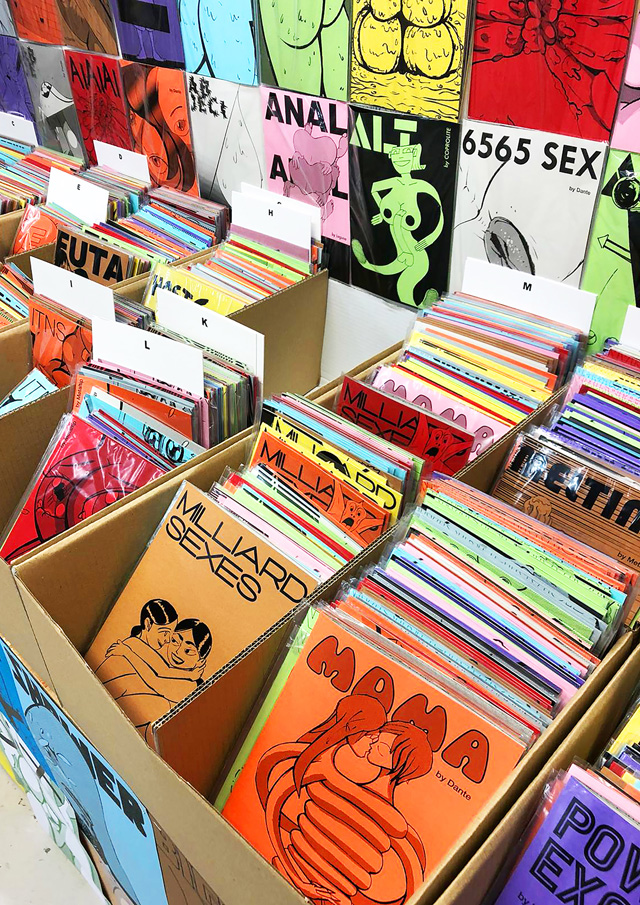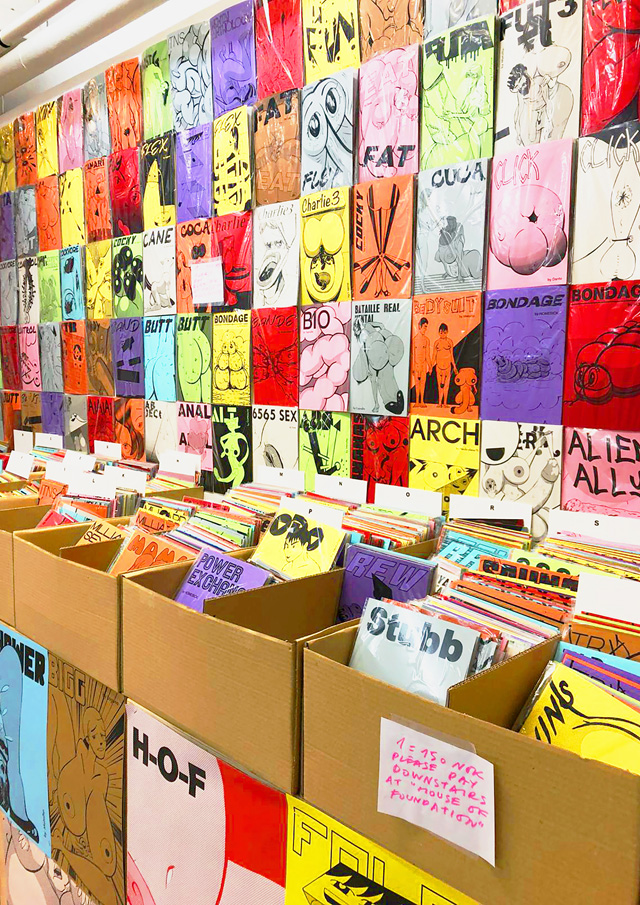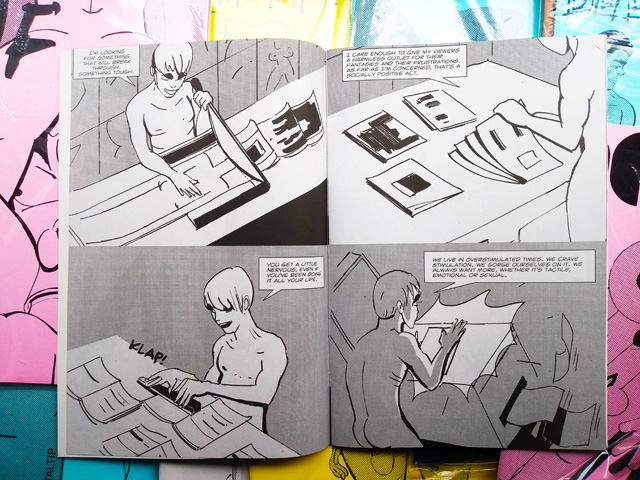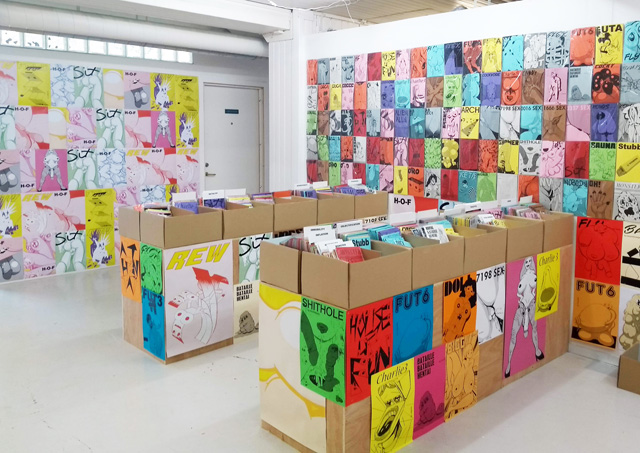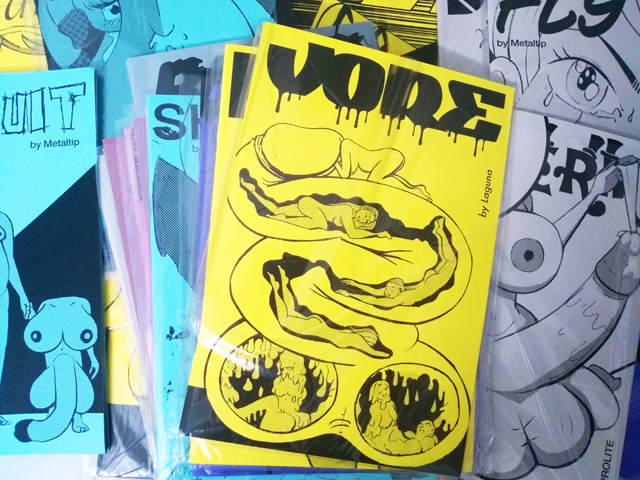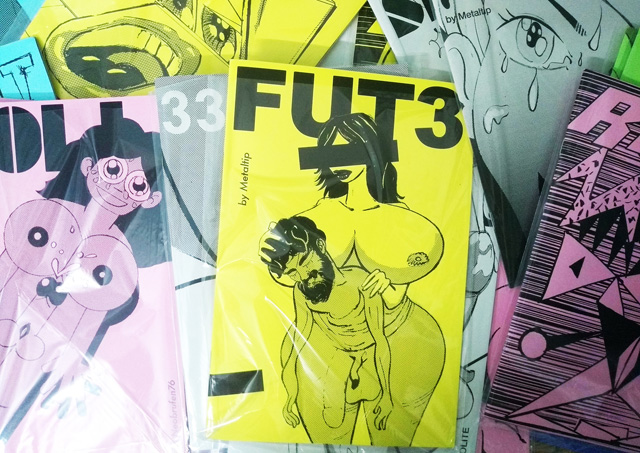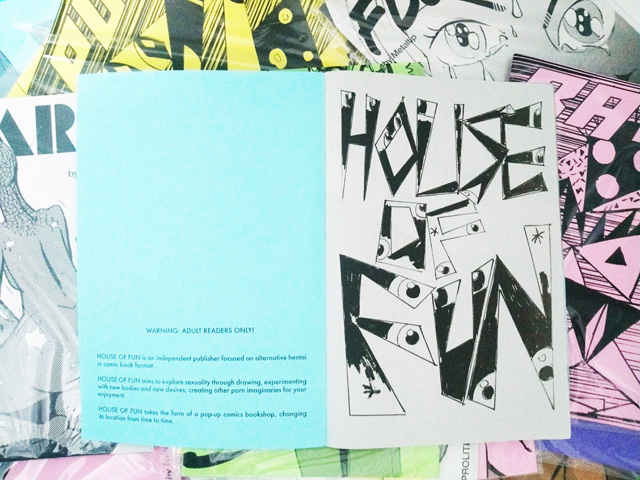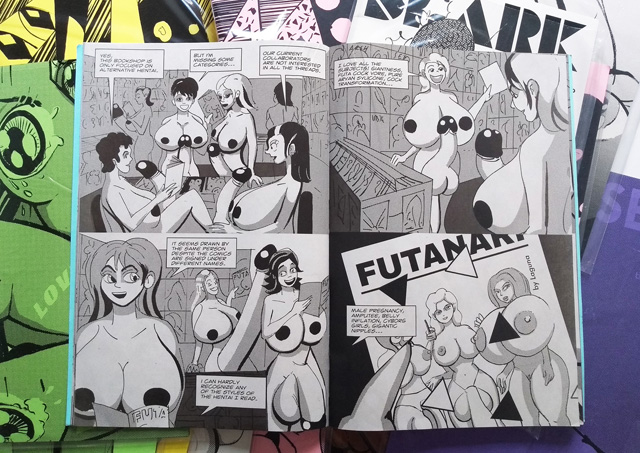

by IZABELLA SCOTT
The Norwegian town of Moss, once known for the smell of glue – it was home to a shoe factory that, residents tell me, gave off a distinctive whiff – is better known these days for Momentum, the Nordic biennial of contemporary art, now in its 10th edition. The Emotional Exhibition (which runs until 9 October 2019), curated by Marti Manen, unfolds over four venues in and around the coastal town, which lies 50km south of Oslo. I arrive to atmospheric grey skies; the sun occasionally breaking through to transform the landscape into a patchwork of vivid, glossy greens. For this edition of the biennial, Manen has brought together 29 artists around the notion of hyperbole, looking at artworks that appeal to the emotions, artworks that make you feel.
[image6]
One such artist courting the senses is Francesc Ruiz (b1971, Barcelona), who presents a new iteration of his alternative porn installation House of Fun (2019), at a bookshop gallery in the centre of Moss. Ruiz’s installation hails the libido: he has created a library of 2,000 zines illustrating different sexual fetishes. Across his practice, Ruiz examines radical subcultures and popular desire through drawing and histories of graphic illustration. A previous iteration of the installation was presented at the 2015 Venice Biennale as Edicola Mundo, a newsstand peddling erotic comics that explored the former Italian president Silvio Berlusconi and the influence of his notorious “bunga bunga” parties (orgies with underage prostitutes) on the Italian media.
This time, Ruiz has delved into 4chan, an online forum founded in 2003 by manga and anime fans, now expanded to serve other subcultures, from “alt-right” politics to fitness and cos-play. Ruiz looked at the adult sections of 4chan, extracting and then illustrating an A-Z of fetish categories, which he refracted through the body horror aesthetics of David Cronenberg and the writings of queer theorist Paul B Preciado. I enter to see a patchwork of pastel-coloured zines lining the walls with striking titles in a variety of fonts. Titles include Amputee, Belly, Cock-Transformation, Cowgirls, Detachable Head, Male Pregnancy, Slob, and Tentacles to name a few. Each zine is illustrated with a drawing, often surreal and always explicit.
[image7]
Ruiz is hopeful – a utopian; his installation explores how notions of gender and sexuality generated by online communities can liberate the libido and potentially build new futures. And yet ethical questions belie Ruiz’s utopia and I sit down with the artist to discuss visual bondage, cartoon physics, the legal limits on drawing, and the quandary around consensual sexual violence.
Izabella Scott: We are sitting in your bookshop installation, surrounded by thousands of zines, which are for sale. The covers illustrate a variety of unusual fetishes. How did you begin to draw and archive such a vast number of desires?
Francesc Ruiz: In my work, I’m thinking about how drawing can give shape to new desires and new bodies, perhaps even to a new future of the body. There is something wonderful about drawing. It has no limits, and I think the body and sexualities can be explored through drawing specifically. Fetishes can be given expression. To speak of this bookshop: there are more than 2,000 different covers, which allude to a range of fetishes, but the zine inside is the same – a comic strip I drew, which is about the bookshop and the community who use the bookshop. I wanted to evoke an imaginary community of authors, but the community is not one I dreamed up, but one I discovered online. People come together on sites such as 4chan to discuss different fetishes and bodily representations. It was on 4chan that I came across some of the strangest fetishes I’ve ever encountered, mainly represented in words or descriptions – familiar categories such as “big” or “anal”, but others that caught my attention, such as “stubb”, “petrification”, “animal genitalia”, “encasement” or “gigantic nipples”. I wanted to explore these fetishes aesthetically, so I began to illustrate these words, to draw different covers, and to write this comic strip, which brings some of these fetishes to life.
[image3]
IS: 4chan combines text and image, but you were looking specifically at concepts?
FR: I was dipping into the subculture and studying it, but illustrating it myself. I wanted to interpret the fetishes via drawing, and to abstract them. When you look around the bookshop, even if there are words you might recognise, the drawings often push fetishes in unexpected directions. This comic titled “Six” for example, which is sitting before us, is illustrated with a torso that has become a face, with blinking nipple-like eyes over its chest. But the torso is also an ass. There’s no head, but, where the head should be, there is an orifice. A cigarette is poking out, so the ass is smoking. I want people to look and say, with excitement: “Wow! what the hell is that?”
IS: Some fetishes, such as “Cut” or “Fold”, relate directly to the world of drawing. In the latter cover image, a man with a long cock is being folded and unfolded, flattened into cardboard. It’s really apt for the bookshop.
FR: “Fold” is one of the most important fetishes because of its relation to the act of printing and drawing. The figure is being flattened – and he loves it. This fetish of being flattened is a kind of visual bondage, which is bondage through drawing. It’s a term that I invented. One of the many desires that BDSM courts is the death drift, or the idea of disappearing, or being flattened. And disappearing also relates to sex in general, because orgasm is a kind of oblivion, an erasure of the self. I became very excited by this flattening fetish in particular, because it relates to the physics of cartoons. The world of the cartoon is flat, and this is where the comic strip I wrote for the exhibition begins. In the opening sequence, there is a man on a bed and, standing over him, is a second man with a large rolling pin. The second man says: “This is the most important part, if someone wants to become an image: flattening!” We watch the first man being rolled out, his body and his penis entering the world of the cartoon. He becomes stretched and flattened into a drawing. Later on, his body is struck with a ruler and guillotined into magazine size sections. It’s a fetish that perfectly relates to zines and to paper.
[image9]
IS: As the comic strip evolves, two women with supersize cocks fight each other, until one woman’s cock snips the other’s apart. Eventually, fragments land on their bodies, like black tape that seems to censor their bodies. Is this another kind of visual bondage, a sort of visual tease?
FR: This is a fetish around censorship, which also relates to the world of printing. Hiding is provocative. It relates to some sites’ policing of online content – Tumblr, for example, or Facebook, which have specific guidelines around what is permitted: such as, no nipples. As you read on, some of the censorship marks turn into speech bubbles. The statements insult the reader, saying things such as: “Is your brain as small as your prick-dick? or “How do you think women act when they’re around a freak like yourself?” Here, aggressive censorship is a kind of a tease, which points to the way in which the inverse of the explicit is also arousing, or the fetish that emerges in the tension between looking and not looking, or in encoding and the invisible.
[image10]
IS: Another zine cover takes the word “Invisibility”, which you illustrate with two androgynous bodies spooning each other, breasts and cocks overlapping in dotted lines. They suggest omission, ellipsis; these figures are there and not there. Historically speaking, invisibility points to the question of how criminalised desires had to be hidden or abstracted. Are you interested in these histories – pornography via metaphor, via encryption?
FR: This very much relates to the history of the pornographic comic. Legally explicit content is a new phenomenon, and often the question of how to encode eroticism was a fascinating constraint. How do you show part of a thing, or show a fetish via metonym, the act of using substitutes. When I discovered the “invisible” fetish online, it became part of my porn-comic workshops, which I run alongside the bookshop installation. These workshops look critically at the history of porn and map a genealogy of LGBT comics – which can be traced back to 19th-century Japanese etchings. One of the exercises I run is: “Drawing invisible porn”, which is more radical than this zine – it means drawing pornographic images with no figures or bodies. I ask: is it possible to represent a fetish using non-representative images? How might we illustrate sexual arousal without figures or genitals?
IS: How far back does the history of pornographic comics go? To the ancient world?
FR: The brothels of Pompeii had pornographic mosaics on their walls; you can see them in the Secret Museum in Naples, where many pornographic elements of Pompeii were hidden – statues with erections, but also pornographic cartoons. The mural of Priapus is famous, an image of a man with a penis that is bigger than his leg. In Greek and Roman mythology, Hermes, the messenger god, was portrayed with a large, exaggerated phallus to signal fertility. The phallus was also a symbol of good luck, and it appears at various crossroads in Rome. There was undoubtedly a great deal of pornography in the ancient world, and it was popular – visible in public spaces, enjoyed by the masses. Nineteenth-century Japanese etchings, on the contrary, were images for the elite, which circulated in rich households, only for the eyes of the few. I’m most interested in parody, humour and the comic form, and the moment when pornography once again becomes a mass phenomenon. Take the Tijuana bibles, for example, which were palm-sized pornographic comic strips produced in the US during the 1920s. They were illegal, bought and sold under the table, and are an example of pre-internet mass porn. The stories in the Tijuana bibles were parodic, taking figures from Hollywood, the world of politics, or the growing ’toon landscape, so you can find erotic interactions between Mae West and Micky Mouse, Popeye and Blondie Bumstead, or Al Capone and Snow White. These “bibles” were made for masturbation; the point was to arouse. They work as a good backdrop for my own porn project, as I create porn imaginaries for mass enjoyment.
[image11]
IS: Did these “bibles” ever illustrate gay sexualities?
FR: They are ultimately heterosexual, which is disappointing, but, even so, there is a whole mix of kinks and taboos – Hitler appears in some storylines, and Mickey Mouse is basically an animal, so there’s often a species crossover. The artist and writers who made these strips are generally unknown. They were printed on cheap paper, in black and white, running to, perhaps, eight pages in length. If you were caught with one, you could be arrested.
IS: What do you consider the first fully gay cartoon? Would it be the work of the Finnish artist Touko Laaksonen, who was known as Tom of Finland?
FR: Tom of Finland is probably one of the greatest influences on gay culture. His drawings date from the late 1950s, pencil drawings of intensified masculinity – lumberjacks, bikers, policemen and sailors, loosely part of the beefcake genre, shown with extremely fetishised bodies: muscles straining against leather jackets, cocks bulging out of jeans. His erotic books entered the mainstream in the 70s, after the decriminalisation of gay pornography. What I find so amazing about Tom of Finland is that his work shows how fantasy can influence culture in a very tangible way. His drawings were a huge influence on the gay leather subculture of the 70s: his drawings helped to crystallise this fetish. Another example is Bara, which is Japanese slang for “men’s love” and used to refer to a strain of homoerotic manga. Bara is equivalent to bear culture in Japan, which is the fetish for large, hairy, burly men. In Bara strips, you see men with big bellies and extreme muscles, and what’s fascinating is that, as Bara became popular in the 60s and 70s, you can see culture follow – bars and street style emerged that matched the drawings. What begins in comics, or the imagination, goes on to create a whole cultural movement.
IS: Tom of Finland’s drawings have a certain wet, shiny quality, as if the pencil captures oiled bodies and leather. The surfaces and soft smoothness evoke bulging arousal. Beyond the erotics of a particular fetish, or even male gay desire, I’m drawn in.
FR: This quality is something that relates to drawing itself. Graphic drawing is different from photography and film; all court realism and have narrative qualities, but graphic drawing is much more closely related to fiction. When I illustrate a story, or a world, I have a contract with the reader, who has to suspend their disbelief, who has to at some believe.
[image12]
IS: Are there any fetishes that you have found you could not represent, even in drawing? Was anything a step too far?
FR: The limits of representation is something that I’m testing. In some ways, I want to believe there are no boundaries, that no sexuality is too extreme, but, of course, there have to be limits. Fetishes around children, for example.
IS: In the UK, the law is extremely strict about what counts as child pornography. Drawings count – and indeed, drawing is recognised as a way in which encrypted pornographic images of children circulate. Do you accept that drawing needs some legal limits?
FR: I agree in principle, but when it comes to drawing, the very nature of the medium makes it difficult to define those laws or limits. For example, I was recently researching “Daddy-Boy”, a popular incest fetish between father and son. It’s represented in an American magazine titled Handjobs, which combines written content with graphics. I contacted one of the illustrators, Bruno Bara, to interviewed him. One thing we discussed was legality in terms of the age of the “boys” he represents. These boys have to be 16 years old, but how do you ensure this in a drawing? What is the difference between a boy who looks 15, and a boy who looks 16? When it comes to drawing, it’s a grey zone. It’s not always easy to define. Bruno told me that sometimes editors say: “No, this boy looks 15; please add some shading to his chin to make him look older. Of course, he complies. It’s interesting to compare this with the mainstream-porn world, where everyone looks young. You might have an actor who is 18 years old, but looks much, much younger – 14 or 15. His participation is legal, but in some ways is much more representative of an illegal fetish than, say, a drawing would be.
IS: Are there any other limits – cannibalism, for example? I’m thinking of Armin Meiwes, the German man who became known as the Rotenburg Cannibal after he met a man online in 2001 and consensually ate his cock. He then killed the man, and was eventually found guilty of murder and sentenced to life imprisonment.
FR: In my comic strip, there’s a cock-eating fantasy, which is the inverse of what you have described. Rather than consuming a cock, the cock consumes you – it’s about entering a supersize penis, being subsumed by it. You enter inside it, like Jonah and the whale, and you eventually get melted into goo, you disappear. This is a disappearance fantasy – to be completely subsumed – which has parallels with this real-life man who wanted to be eaten. But in my fantasy version, it’s done with love rather than violence.
IS: In your version, it’s also clear that reality or realism has been left behind. First, because of scale – the cock is supersize, a whole body fits inside it, which signals we are “through the looking-glass”, so to speak. It means that the fetish becomes obviously a metaphor or fantasy, rather than representing a desire to be eaten, literally. This distinction feels crucial.
FR: My fetish exists only on the plane of drawing; it’s only possible within cartoon physics. For me, fetish and fantasy are deeply connected. Of course, I love the idea that fetish can influence culture – as with Tom of Finland or Bara – and today there are so many ways we can physically deconstruct gender or alter our bodies. We are entering a post-human era. Gender can be reassigned. We could all be taking Testogel for fun, as Paul B Preciado sets out in the memoir Testo Junkie (2008). While I love all these ideas, I also think that some fetishes don’t ever have to cross over into reality. They can stay in the realm of fantasy. Have you ever tried VR porn? I was with a friend last Christmas and he passed me a headset without explaining what I was about to see. When I put it over my eyes, I was transported into a porn film. I was in a room with naked people all around me. When I looked down at my body, I was a woman. Then a guy came over and he began to have sex with me. It was surreal. This is the future.
IS: I agree in principle that a radically violent sexual fantasy – being eaten, being cut up – is not the same as a radically violent sexual act. But they are connected. How do you keep the nuance?
FR: There’s a sophistication to fantasy. Human nature is complex. Sexuality is complex – and that’s part of its gift. I really believe that you can take joy in the fantasy, without it ever being something you actually have to “do”. Aside from actions that are legally wrong – killing somebody, for example, as Meiwes did – the simplest way to define what is OK and what is not OK, is via consent. Nothing is too far if it’s consensual and legal – and with various sex apps, it’s fairly easy to match up with somebody who has compatible desires. The question then is who can consent? Children cannot content. Animals cannot consent. People with mental disabilities cannot consent. Saying all this, I feel that in the realm of drawing, a place of fantasy and abstraction, nearly anything goes. Here, you can think it, draw it, feel it. It doesn’t mean you have to do it.
IS: I worry that in an era of online surveillance, consumers of radical porn may be held accountable for their fetishes. The UK government’s anti-radicalisation programme, Prevent, for example, is based around the logic of pre-criminal screening. It tries to catch people before they have committed a radical act, by working out if they may conceivably have had a radical thought. The logic says that thinking is the same as doing; one leads to the other.
FR: I think it’s a very dangerous legal framework to start conflating fiction and action. It’s a way of shutting down creative acts. I’m interested in subversion and in acts of reclaiming – in going back into history, and mining what is there for contemporary purposes. One of the problems for queers with visual erotic histories is that most are very heterosexual, or authored by straight people. Often, historic gay content is homophobic. Take Tintin in Thailand (1999), for example, which is a porn parody of Tintin. The gay adventures of Tintin are a way to make fun of his character; it’s an insult, a slur. And yet, I believe it’s possible, even exciting, to take these comics and reclaim them. Another visual history that I’m really interested in is the production of gay comics in Italy during the 1970s and 80s by the editor Renzo Barbieri. These gay comics were made by heterosexual illustrators, and they are totally homophobic, drawing on stereotypes and explicitly insulting gays via straight humour. At the same time, I can’t help but think that to take so much pleasure in the “joke” suggests a latent homoeroticism. Yes, Barbieri's company was profiting from the production of these homophobic comics, but there’s also imagery to co-opt, flip, reclaim. And what else do we have? My ongoing comic book project Ronaldo e Gary (2015-) reflects on LGBT memory, as I attempt to dehomophobise comic-book history, stealing from the past to create new images.
IS: The list of fetishes I can see on the walls of this bookshop are pretty wild, and often amusing. To name some we haven’t touched on: Inflation, Cyborg Girls, Giantess Voice, Monster, Bodysuit, Slime … I’m also interested in Yaoi, a more historical genre that goes back to the 60s in Japan. Could you tell me a little more about it?
FR: The Yaoi subculture is really interesting. It’s manga stories of boy-on-boy love, but they have been created by women, for women. In other words, women drawing gay male porn for their own consumption. This porn does not take the place of lesbian porn by lesbians for lesbians – there’s that, too. It’s just another strain, for women (often straight women) who find porn misogynist, or something that doesn’t represent them. Yaoi porn stories are hyperemotionalised, are written by fans and usually feature one very dominant lover pursuing another who is extremely submissive. There is so much to analyse and learn. I have just launched a Porn Studies Institute in Barcelona (institutodelporno.org) with two colleagues, Ona Bros and Lucía Egaña. To begin with, we are focusing on the Spanish-speaking context, and we run workshops about queer porn and the 3D printing of new sexual objects in collaboration with artists such as Belén Soto.
IS: The 3D printing of sex objects has such wild implications. In the future, you could potentially print celebrity cocks on demand …
FR: It’s already happening! One artist I know has been 3D-modelling the sexual organs of insects, and printing them in human size, so you can feel what it’s like to have sex with an insect. You look sceptical … I’m an optimist. Really, I can’t wait to see what the future holds.
• Francesc Ruiz’s House of Fun is at House of Foundation as part of Momentum 10 in Moss, Norway, until 9 October 2019.


